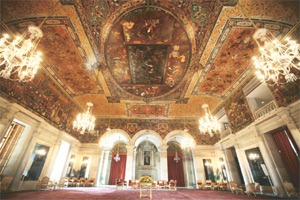 A fifth-century Buddha figure keeps watch over a neatly-arranged row of chairs facing the chair of the President of India. It’s a room steeped in history. This is where Nehru took his oath as the country’s first Prime Minister. But it is not merely the architectural glory of the Durbar Hall, the circular room right below the central dome of the Rashtrapati Bhavan, that leaves people awed. It is also the access to one of the seats of Indian history that overwhelms them. Since Pranab Mukherjee took over as president on July 25 last year, he has initiated a process to make the Rashtrapati Bhavan as “open as possible to the people,” much like the White House in America or other presidential abodes across the world. Read more
A fifth-century Buddha figure keeps watch over a neatly-arranged row of chairs facing the chair of the President of India. It’s a room steeped in history. This is where Nehru took his oath as the country’s first Prime Minister. But it is not merely the architectural glory of the Durbar Hall, the circular room right below the central dome of the Rashtrapati Bhavan, that leaves people awed. It is also the access to one of the seats of Indian history that overwhelms them. Since Pranab Mukherjee took over as president on July 25 last year, he has initiated a process to make the Rashtrapati Bhavan as “open as possible to the people,” much like the White House in America or other presidential abodes across the world. Read more
